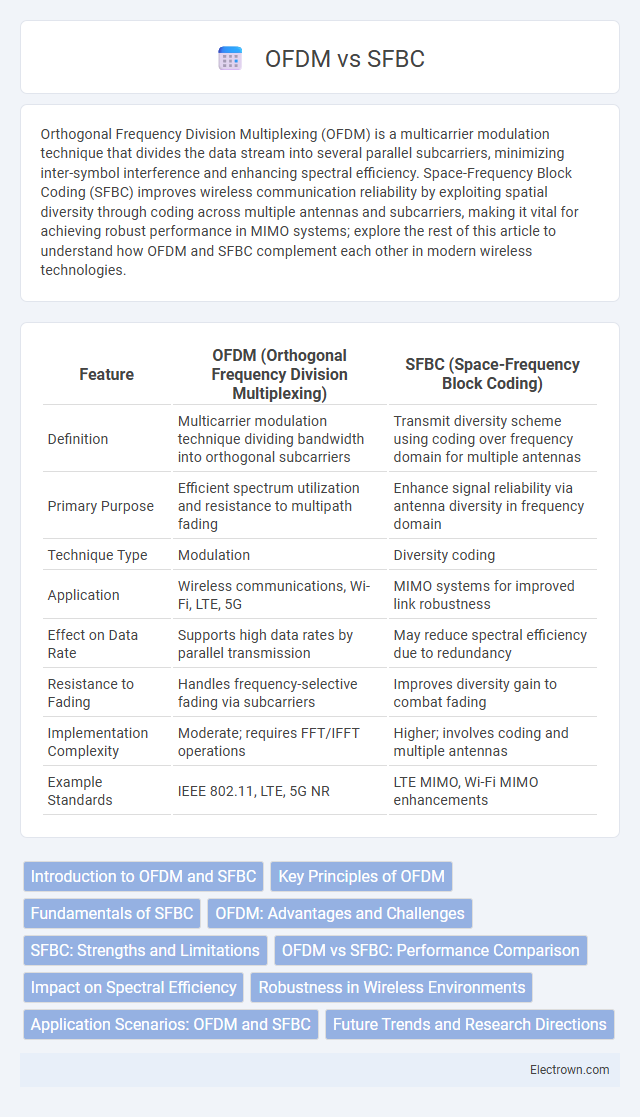Orthogonal Frequency Division Multiplexing (OFDM) is a multicarrier modulation technique that divides the data stream into several parallel subcarriers, minimizing inter-symbol interference and enhancing spectral efficiency. Space-Frequency Block Coding (SFBC) improves wireless communication reliability by exploiting spatial diversity through coding across multiple antennas and subcarriers, making it vital for achieving robust performance in MIMO systems; explore the rest of this article to understand how OFDM and SFBC complement each other in modern wireless technologies.
Table of Comparison
| Feature | OFDM (Orthogonal Frequency Division Multiplexing) | SFBC (Space-Frequency Block Coding) |
|---|---|---|
| Definition | Multicarrier modulation technique dividing bandwidth into orthogonal subcarriers | Transmit diversity scheme using coding over frequency domain for multiple antennas |
| Primary Purpose | Efficient spectrum utilization and resistance to multipath fading | Enhance signal reliability via antenna diversity in frequency domain |
| Technique Type | Modulation | Diversity coding |
| Application | Wireless communications, Wi-Fi, LTE, 5G | MIMO systems for improved link robustness |
| Effect on Data Rate | Supports high data rates by parallel transmission | May reduce spectral efficiency due to redundancy |
| Resistance to Fading | Handles frequency-selective fading via subcarriers | Improves diversity gain to combat fading |
| Implementation Complexity | Moderate; requires FFT/IFFT operations | Higher; involves coding and multiple antennas |
| Example Standards | IEEE 802.11, LTE, 5G NR | LTE MIMO, Wi-Fi MIMO enhancements |
Introduction to OFDM and SFBC
OFDM (Orthogonal Frequency Division Multiplexing) is a multicarrier modulation technique that divides a wide frequency band into multiple orthogonal subcarriers to transmit data simultaneously, enhancing spectral efficiency and resistance to multipath fading. SFBC (Space-Frequency Block Coding) is a transmit diversity scheme applied in multi-antenna OFDM systems, encoding data across spatial and frequency domains to improve signal reliability and combat channel fading. Understanding the roles of OFDM and SFBC helps optimize your wireless communication system's performance under various channel conditions.
Key Principles of OFDM
Orthogonal Frequency Division Multiplexing (OFDM) divides a high-rate data stream into multiple lower-rate streams transmitted simultaneously over different orthogonal subcarriers, minimizing inter-symbol interference and improving spectral efficiency. This technique leverages the Fast Fourier Transform (FFT) for efficient modulation and demodulation, allowing robust performance in multipath fading environments. Your wireless communication systems benefit from OFDM's ability to support high data rates and resilience against channel impairments, making it a foundational technology in modern broadband standards.
Fundamentals of SFBC
Space-Frequency Block Coding (SFBC) is a multiple antenna transmission technique that enhances wireless communication reliability by exploiting both spatial and frequency diversity. It encodes data across multiple transmitting antennas and adjacent subcarriers in Orthogonal Frequency Division Multiplexing (OFDM) systems to combat frequency-selective fading and improve signal robustness. SFBC's fundamental operation compares to Space-Time Block Coding (STBC), but its encoding occurs in the frequency domain, making it well-suited for OFDM-based wireless standards such as LTE and Wi-Fi.
OFDM: Advantages and Challenges
OFDM (Orthogonal Frequency Division Multiplexing) offers advantages such as high spectral efficiency, robustness to multipath fading, and simplified equalization, making it ideal for high-speed wireless communication. Challenges include sensitivity to frequency offset and Doppler shifts, resulting in inter-carrier interference, and the requirement for precise synchronization. OFDM also suffers from high peak-to-average power ratios (PAPR), which can reduce power amplifier efficiency.
SFBC: Strengths and Limitations
Space-Frequency Block Coding (SFBC) enhances signal reliability and diversity gain in multi-antenna OFDM systems by encoding data across multiple antennas and subcarriers, effectively combating frequency-selective fading. SFBC's strengths include improved bit error rate (BER) performance and robustness in multipath environments, especially in slow-fading channels where channel state information remains constant over frequencies. However, SFBC introduces additional complexity in transmitter design and suffers performance degradation in rapidly time-varying channels due to its reliance on channel consistency across subcarriers.
OFDM vs SFBC: Performance Comparison
OFDM (Orthogonal Frequency Division Multiplexing) offers high spectral efficiency and robustness against multipath fading, making it ideal for broadband wireless communication. SFBC (Space-Frequency Block Coding) enhances OFDM by providing transmit diversity, significantly improving bit error rate performance in fading channels without sacrificing bandwidth efficiency. Your choice between OFDM and SFBC depends on the need for diversity gain versus complexity, with SFBC outperforming OFDM in environments with severe multipath conditions.
Impact on Spectral Efficiency
Orthogonal Frequency Division Multiplexing (OFDM) offers high spectral efficiency by dividing the bandwidth into multiple orthogonal subcarriers, enabling simultaneous data transmission without significant inter-carrier interference. Space-Frequency Block Coding (SFBC) enhances signal reliability and diversity in OFDM systems but introduces redundancy across subcarriers, which slightly reduces the overall spectral efficiency. Despite this reduction, SFBC's trade-off improves link robustness in multipath fading environments, making it valuable for reliable wireless communication.
Robustness in Wireless Environments
Orthogonal Frequency Division Multiplexing (OFDM) offers robust performance in multipath wireless environments by dividing the channel into multiple narrowband subcarriers, minimizing inter-symbol interference. Space-Frequency Block Coding (SFBC) enhances this robustness by introducing spatial diversity, transmitting redundant signals across multiple antennas to combat fading and improve reliability. Your wireless system benefits significantly from SFBC's ability to maintain data integrity in challenging, time-varying channels where OFDM alone might struggle.
Application Scenarios: OFDM and SFBC
OFDM (Orthogonal Frequency Division Multiplexing) excels in high-speed wireless communications such as Wi-Fi, LTE, and 5G networks, offering efficient data transmission over multipath channels. SFBC (Space-Frequency Block Coding) enhances reliability in MIMO systems by providing diversity gain, making it ideal for environments with severe fading like mobile vehicular networks or indoor broadcasting. Your choice between OFDM and SFBC depends on whether the priority is maximizing data rates or improving signal robustness in complex wireless conditions.
Future Trends and Research Directions
Future trends in OFDM and SFBC research emphasize enhancing spectral efficiency and robustness against multipath fading for next-generation wireless networks. Researchers are exploring advanced coding schemes, adaptive modulation techniques, and machine learning algorithms to optimize SFBC performance within OFDM systems. Your wireless communication systems can benefit from these innovations by achieving improved reliability and throughput in dynamic channel environments.
OFDM vs SFBC Infographic

 electrown.com
electrown.com